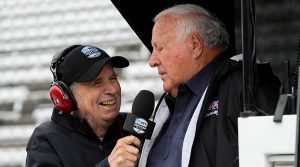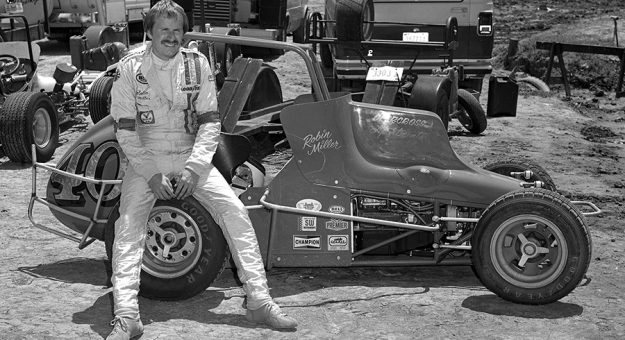For the next 10 years, Miller was a USAC midget racer in addition to covering auto racing at The Star.
“I’m writing 52 columns a year about USAC racing because at that time, USAC was on top,” Miller recalled. “I flunked out of Ball State in 1971 and that is hard to do. It’s hard to flunk out of Ball State. You have to try.
“It’s sad that my Mom and Dad didn’t get to go to college and I threw mine away.”
With help from racing buddies Larry Rice, Johnny Parsons and the Bettenhausen brothers, Miller developed into a driver quick enough to qualify fifth for the 1980 Hut Hundred midget race at the Terre Haute Action Track, a prestigious dirt event featuring 33 cars lined up in 11 rows of three. However, a blown engine forced him out of the race.
Miller survived a crash into a telephone pole in the Indiana State Fairgrounds parking lot when he started the car without buckling up. The throttle stuck, launching the powerful machine unexpectedly and dangerously forward.
In an even more serious situation, Miller suffered a head injury in hot laps at a 1975 midget race in Hinsdale, Ill., when he flipped his car into a concrete wall, tearing the cage off.
Ultimately, Miller would be elevated to one of the columnists at The Star. He was never afraid to voice his opinion, which quickly put him at odds with the likes of fiery Indiana University basketball coach Bob Knight.
He wrote a column calling A.J. Foyt a cheater and the next day, Foyt punched him on pit lane in front of 30,000 fans at Indianapolis Motor Speedway.
He had famous feuds in the 1990s with Indianapolis Colts quarterback Jeff George and Indianapolis Motor Speedway owner Tony George.
By that time, Miller had established himself as one of the leading and most colorful journalists in the country. He would call out anyone if he believed it were justified and didn’t worry about the consequences.
For as colorful as he was at his job, Miller’s entire life was outrageous at times.
The man never drank, but he never saw a bet he didn’t want to make. He loved the action.

But The Star began to undergo a transformation. In the 1960s, 1970s and 1980s, Indianapolis was a sleepy little town in the summer and earned the nickname “Nap Town.” Miller recalls many a newspaper shift where the staff would go on dinner break to the bar down the block and only half of the staff would ever return to put out the paper.
By the late 1990s, however, that had changed. His feud with the George and Indianapolis Motor Speedway over the creation of the Indy Racing League against the more established CART had not only split the sport, but the fan base and the community as well.
Miller was outspokenly in favor of CART. When The Star made certain business decisions to help IMS and IRL, Miller often criticized his employers, but made the mistake of doing it through The Star’s email server.
Combine that along with some other questionable communications and the news leadership of The Star unceremoniously fired him in 2001.
There was no Gold Watch, no Farewell Dinner, there may not have been any severance. Miller was gone.
But he was not out.
ESPN quickly hired him. Suddenly, Miller’s platform became bigger. He was no longer the sports voice of Central Indiana. He was in the midst of creating a national following. Miller became a television personality first with ESPN, then SPEED and most recently NBC. He also had long stints at all of Indianapolis’ TV affiliates through the years.
Miller’s journalism career began at The Star in 1968, and he never retired from writing about auto racing. His stories and columns were featured in SPEED SPORT, Autoweek, Car and Driver, Sports Illustrated and RACER, among other notable publications and websites, and for years he hosted shows on Indianapolis radio stations as he was a master storyteller.
But at his roots, Miller remained a newspaperman.
“God, I miss the newspaper business so much,” Miller once confided to me. “I miss the reporting, doing the layout, putting the paper together, calling sources. I still get to do that where I’m at now, but I miss the daily life of being a newspaper guy.”
In later years, however, Miller began to realize that getting fired from The Indianapolis Star would prove to be the greatest thing to ever happen to him.
He went from being a Hoosier Hero to the leading voice of auto racing throughout the United States.
Click below to continue reading.
